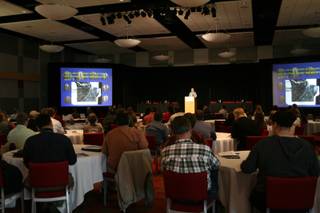Wednesday, Jan. 14, 2009 | 1:55 a.m.
Beyond the Sun
Sun Topics
The UNLV student union was buzzing with chatter Tuesday, but it wasn’t all about the new semester. Instead, it was about quagga mussels and phytoplankton levels during a gathering of the first Lake Mead Science Symposium.
The forum of 150 people from 30 agencies came together to discuss the findings of land and water studies from the Lake Mead National Recreational Center. UNLV executive associate dean Shawn Gerstenberger said the symposium is the final part of a grant funded through the Southern Nevada Public Lands Act.
“We applied for grant funding because it was consistent with the theme of the grant and the needs of the community and the needs of the park services,” Gerstenberger said. “We applied for the grant and were rewarded the money and all of the agencies got involved.”
Kent Turner, chief of resource management at the Lake Mead National Recreation Area, said the quagga mussel is near the top of the problem list. Quagga mussels filter the water and can wipe out phytoplankton, which is the base of the food chain. They tend to grow in clumps around structures, like drinking water pipes.
“There’s a huge maintenance requirement now based on Southern Nevada Water Authority, Hoover Dam and parks service facilities,” Turner said. “We’ve spent $1.8 million since quagga mussels have been discovered at Lake Mead.”
Not only was the symposium meant to avoid overlapping research, but also to share information.
Ron Veley, a physical scientist and the project chief for the U.S. Geological Survey’s Lake Mead monitoring network, said the end results include providing safe drinking water and useful information to the public.
Veley, who has been on the Lake Mead monitoring project for about five years, said the research presented at the symposium wasn’t surprising. He said research showed trends one would expect to find in a body of water such as Lake Mead.
“This is a symposium which is basically a presentation of findings from research and research projects and studies … but it’s not about a brainstorming on how to (solve issues),” Turner said.
The symposium is open to anyone who registers and continues until 5 p.m. Wednesday at UNLV’s Student Union Ballroom.


Join the Discussion:
Check this out for a full explanation of our conversion to the LiveFyre commenting system and instructions on how to sign up for an account.
Full comments policy